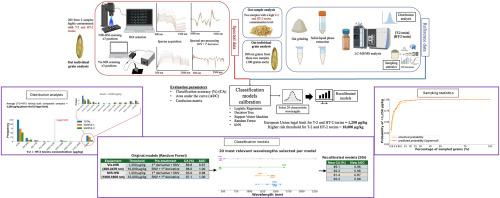可见-近红外光谱和近红外高光谱成像技术检测燕麦籽粒中T-2和HT-2毒素
IF 6.3
1区 农林科学
Q1 FOOD SCIENCE & TECHNOLOGY
引用次数: 0
摘要
燕麦谷物因其对健康的益处而在世界范围内被越来越多地食用,但它们极易受到镰刀菌毒素的污染,特别是T-2和HT-2毒素(T-2+HT-2)。这些毒素构成严重的健康风险,而且分布不均,少数受到严重污染的谷物往往会导致一批食品超过法定安全限制。目前的检测方法是破坏性的,缓慢的,或者不足以检测单个颗粒水平的污染。这项研究首次证明了可见光-近红外光谱(Vis-NIR)和近红外高光谱成像(NIR-HSI)在单个燕麦颗粒中非破坏性检测T-2+HT-2的潜力。用液相色谱-串联质谱法(LC-MS/MS)测定了200粒玉米的毒素含量。建立了超过欧盟法定阈值(1250 μg/kg)和更高风险水平(10,000 μg/kg)的分类模型。这两种技术在鉴别污染谷物方面都取得了较高的准确度(高达94.5%)。确定了关键波长(例如,近红外波段为1203、1419、1424和1476 nm;可见光波段为440 - 455nm),并将模型减少到20个波长,在简化计算的同时保持了性能。至关重要的是,只要去除21.5%污染最严重的谷物,就可以将总体毒素水平降低95%以上。此外,抽样模拟显示,分析30%的谷物可以保证检测出超过法定限度的污染,而0.5%的抽样只产生25 - 33%的检测机会。这些发现强调了将光谱筛选整合到工业燕麦分选线、提高食品安全、减少经济损失和克服传统霉菌毒素监测的主要局限性的可行途径。本文章由计算机程序翻译,如有差异,请以英文原文为准。

Visible-near infrared spectroscopy and near-infrared hyperspectral imaging for the detection of T-2 and HT-2 toxins in individual oat grains
Oat grains are increasingly consumed worldwide due to their health benefits, yet they are highly susceptible to contamination by Fusarium toxins, particularly T-2 and HT-2 toxins (T-2+HT-2). These toxins pose serious health risks and are unevenly distributed, with a few highly contaminated grains often driving a batch over legal safety limits. Current detection methods are destructive, slow, or inadequate for detecting contamination at the individual grain level. This study is the first to demonstrate the potential of visible–near-infrared (Vis-NIR) spectroscopy and near-infrared hyperspectral imaging (NIR-HSI) to detect T-2+HT-2 in individual oat grains non-destructively. 200 grains were scanned, and their toxin content quantified by liquid chromatography-tandem mass spectrometry (LC-MS/MS). Classification models were developed to identify grains exceeding both the European Union (EU) legal threshold (1250 μg/kg) and a higher risk level (10,000 μg/kg). Both techniques achieved high accuracy (up to 94.5 %) in identifying contaminated grains. Key wavelengths were identified (e.g., 1203, 1419, 1424 and 1476 nm in NIR; 440–455 nm in Vis), and reducing the model to 20 wavelengths preserved performance while simplifying computation. Critically, removing just 21.5 % of the most contaminated grains could reduce overall toxin levels by over 95 %. Moreover, sampling simulations revealed that analysing 30 % of grains guarantees detection of contamination above legal limits, whereas 0.5 % sampling yields only a 25–33 % detection chance. These findings highlight a feasible path for integrating spectroscopic screening into industrial oat sorting lines, improving food safety, reducing economic losses, and overcoming key limitations of conventional mycotoxin monitoring.
求助全文
通过发布文献求助,成功后即可免费获取论文全文。
去求助
来源期刊

Food Control
工程技术-食品科技
CiteScore
12.20
自引率
6.70%
发文量
758
审稿时长
33 days
期刊介绍:
Food Control is an international journal that provides essential information for those involved in food safety and process control.
Food Control covers the below areas that relate to food process control or to food safety of human foods:
• Microbial food safety and antimicrobial systems
• Mycotoxins
• Hazard analysis, HACCP and food safety objectives
• Risk assessment, including microbial and chemical hazards
• Quality assurance
• Good manufacturing practices
• Food process systems design and control
• Food Packaging technology and materials in contact with foods
• Rapid methods of analysis and detection, including sensor technology
• Codes of practice, legislation and international harmonization
• Consumer issues
• Education, training and research needs.
The scope of Food Control is comprehensive and includes original research papers, authoritative reviews, short communications, comment articles that report on new developments in food control, and position papers.
 求助内容:
求助内容: 应助结果提醒方式:
应助结果提醒方式:


